Efficacy of Lactic Acid Bacteria as a Biocontrol Agent against Anthracnose (Persea americana Miller) Decay in Avocado (Persea americana) cv Fuerte Fruit
Abstract
:1. Introduction
2. Materials and Methods
2.1. Chemicals and Microbial Cultures
2.2. Preparation of Microbial Cultures
2.3. Efficacy of LAB Strains and Mechanism of C. gloeosporioides Mycelial Growth Inhibition
2.4. Inhibitory Effect of LAB Strains on Fungal Spore Germination
2.5. Competition for Nutrients
2.6. Acid Tolerance of C. gloeosporioides
2.7. Determination of Biofilm Formation against C. gloeosporioides
2.8. Control of Anthracnose Incidence and Severity in Avocado cv Fuerte Fruit In Vivo
2.8.1. Fruit Preparation
2.8.2. Inoculation and Control of Anthracnose Disease in Avocado Fruit
2.8.3. Recovery of the C. gloeosporioides and LAB Strains from Curative and Preventatively Inoculated “Fuerte” Avocado Fruit
2.9. Epicatechin Contents in Inoculated and Naturally Infected Avocado Fruit
2.10. Expression of Defence-Related Genes in Curatively Treated Avocado Fruit
2.10.1. Ribonucleic Acid (RNA) Extraction and Primer Design
2.10.2. Reverse Transcription and Quantitative Real-Time PCR
2.11. Statistical Analysis
3. Results and Discussion
3.1. The Effects of LAB Strains on the Mycelial Growth Inhibition of C. gloeosporioides
3.2. Effects of LAB Strains on C. gloeosporioides Spore Germination
3.3. Competition for Nutrients between LAB Strains and C. gloeosporioides
3.4. Acid Tolerance of C. gloeosporioides
3.5. Effect of Incubation Time on the Production of Biofilms against Colletotrichum gloeosporioides
3.6. Disease Incidence and Severity in LAB-Treated Avocado Fruit
3.7. LAB and Fungal Pathogen Recovery in Infected Avocado Fruit
3.8. Effects of LAB Strains on the Epicatechin Content in Treated Avocado Fruit
3.9. Effects of LAB Treatments on the Expression of Defense-Related Genes in Avocado Fruit
4. Conclusions
Supplementary Materials
Author Contributions
Funding
Institutional Review Board Statement
Data Availability Statement
Conflicts of Interest
References
- Ramírez-Gil, J.G.; Ramelli, E.G.; Osorio, J.G.M. Economic impact of the avocado (cv. Hass) wilt disease complex in Antioquia, Colombia, crops under different technological management levels. Crop Prot. 2017, 101, 103–115. [Google Scholar] [CrossRef]
- Li, M.; Feng, W.; Yang, J.; Gao, Z.; Zhang, Z.; Zhang, W.; Wang, S.; Wang, W.; Gong, D.; Hu, M. First report of anthracnose caused by Colletotrichum siamense on avocado fruits in China. Crop Prot. 2022, 155, 105922. [Google Scholar] [CrossRef]
- Guan, V.X.; Neale, E.P.; Probst, Y.C. Consumption of avocado and associations with nutrient, food and anthropometric measures in a representative survey of Australians: A secondary analysis of the 2011–2012 National Nutrition and Physical Activity Survey. Br. J. Nutr. 2022, 128, 932–939. [Google Scholar] [CrossRef] [PubMed]
- Tesfaye, T.; Mebrate, M.A.; Gibril, M.; Ferede, E.; Limeneh, D.Y.; Kong, F. Beneficiation of avocado processing industry by-product: A review on future prospect. Curr. Res. Green Sustain. Chem. 2022, 5, 100253. [Google Scholar] [CrossRef]
- de Oliveira, T.S.; Costa, A.M.M.; Cabral, L.M.C.; Freitas-Silva, O.; Rosenthal, A.; Tonon, R.V. Anthracnose Controlled by Essential Oils: Are Nanoemulsion-Based Films and Coatings a Viable and Efficient Technology for Tropical Fruit Preservation? Foods 2023, 12, 279. [Google Scholar] [CrossRef]
- Sharma, M.; Kulshrestha, S. Colletotrichum gloeosporioides: An anthracnose causing pathogen of fruits and vegetables. Biosci. Biotechnol. Res. Asia 2015, 12, 1233–1246. [Google Scholar] [CrossRef]
- Ramírez-Gil, J.G.; Henao-Rojas, J.C.; Morales-Osorio, J.G. Postharvest diseases and disorders in avocado cv. Hass and their relationship to preharvest management practices. Heliyon 2021, 7, e05905. [Google Scholar] [CrossRef]
- Tian, F.; Qiao, C.; Wang, C.; Pang, T.; Guo, L.; Li, J.; Pang, R.; Xie, H. Dissipation behavior of prochloraz and its metabolites in grape under open-field, storage and the wine-making process. J. Food Compos. Anal. 2022, 114, 104846. [Google Scholar] [CrossRef]
- Sellamuthu, P.S.; Sivakumar, D.; Soundy, P.; Korsten, L. Essential oil vapours suppress the development of anthracnose and enhance defence related and antioxidant enzyme activities in avocado fruit. Postharvest Biol. Technol. 2013, 81, 66–72. [Google Scholar] [CrossRef] [Green Version]
- Mokgalapa, N.; Akinola, S.A.; Shoko, T.; Pillai, S.K.; Sivakumar, D. Chitosan molecular weights affect anthracnose incidence and elicitation of defence-related enzymes in avocado (Persea americana) cultivar ‘Fuerte’. Int. J. Food Microbiol. 2022, 366, 109561. [Google Scholar] [CrossRef]
- Osondu, H.A.A.; Akinola, S.A.; Shoko, T.; Pillai, S.K.; Sivakumar, D. Coating properties, resistance response, molecular mechanisms and anthracnose decay reduction in green skin avocado fruit (‘Fuerte’) coated with chitosan hydrochloride loaded with functional compounds. Postharvest Biol. Technol. 2022, 186, 111812. [Google Scholar] [CrossRef]
- Pranaw, K.; Dutta, D.; Singh, S.; Khare, S.K. Lactic Acid Bacteria for Production of Platform Chemicals: A Dark Horse in the Field of Industrial Biotechnology. In Advances in the Domain of Environmental Biotechnology; Springer: Singapore, 2021; pp. 3–25. [Google Scholar] [CrossRef]
- So, Y.M.; Seo, Y.J. Characterization of the Psychrotrophic Lactic Acid Bacterium Leuconostoc gelidum subsp. aenigmaticum LS4 Isolated from Kimchi Based on Comparative Analyses of Its Genomic and Phenotypic Properties. Foods 2021, 10, 1899. [Google Scholar] [CrossRef]
- Fessard, A.; Kapoor, A.; Patche, J.; Assemat, S.; Hoarau, M.; Bourdon, E.; Bahorun, T.; Remize, F. Lactic fermentation as an efficient tool to enhance the antioxidant activity of tropical fruit juices and teas. Microorganisms 2017, 5, 23. [Google Scholar] [CrossRef] [PubMed]
- Bibi, A.; Xiong, Y.; Rajoka, M.S.R.; Mehwish, H.M.; Radicetti, E.; Umair, M.; Shoukat, M.; Khan, M.K.I.; Aadil, R.M. Recent Advances in the Production of Exopolysaccharide (EPS) from Lactobacillus spp. and its application in the food industry: A Review. Sustainability 2021, 13, 12429. [Google Scholar] [CrossRef]
- Granada, D.; Lopez-Lujan, L.; Ramirez-Restrepo, S.; Morales, J.; Pelaez-Jaramillo, C.; Andrade, G.; BEDOYA-PÉREZ, J.C. Bacterial extracts and bioformulates as a promising control of fruit body rot and root rot in avocado cv. Hass. J. Integr. Agric. 2020, 19, 748–758. [Google Scholar] [CrossRef]
- Managa, M.G.; Akinola, S.A.; Remize, F.; Garcia, C.; Sivakumar, D. Physicochemical parameters and bioaccessibility of lactic acid bacteria fermented chayote Leaf (Sechium edule) and pineapple (Ananas comosus) smoothies. Front. Nutr. 2021, 8, 649189. [Google Scholar] [CrossRef] [PubMed]
- Cele, N.P.; Akinola, S.A.; Manhivi, V.E.; Shoko, T.; Remize, F.; Sivakumar, D. Influence of Lactic Acid Bacterium Strains on Changes in Quality, Functional Compounds and Volatile Compounds of Mango Juice from Different Cultivars during Fermentation. Foods 2022, 11, 682. [Google Scholar] [CrossRef]
- Zamani-Zadeh, M.; Soleimanian-Zad, S.; Sheikh-Zeinoddin, M.; Goli, S.A.H. Integration of Lactobacillus plantarum A7 with thyme and cumin essential oils as a potential biocontrol tool for gray mold rot on strawberry fruit. Postharvest Biol. Technol. 2014, 92, 149–156. [Google Scholar] [CrossRef]
- Obianom, C.; Sivakumar, D. Differential response to combined prochloraz and thyme oil drench treatment in avocados against the control of anthracnose and stem-end rot. Phytoparasitica 2018, 46, 273–281. [Google Scholar] [CrossRef]
- Zhang, H.; Mahunu, G.K.; Castoria, R.; Apaliya, M.T.; Yang, Q. Augmentation of biocontrol agents with physical methods against postharvest diseases of fruits and vegetables. Trends Food Sci. Technol. 2017, 69, 36–45. [Google Scholar] [CrossRef]
- Sadishkumar, V.; Jeevaratnam, K. In vitro probiotic evaluation of potential antioxidant lactic acid bacteria isolated from idli batter fermented with Piper betle leaves. Int. J. Food Sci. Technol. 2017, 52, 329–340. [Google Scholar] [CrossRef]
- Akinola, S.A.; Tshimpamba, M.E.; Mwanza, M.; Ateba, C.N. Biofilm Production Potential of Serovars Isolated from Chickens in North West Province, South Africa. Pol. J. Microbiol. 2020, 69, 427–439. [Google Scholar] [CrossRef] [PubMed]
- Hossain, M.; Iqbal, A. Effect of shrimp chitosan coating on postharvest quality of banana (Musa sapientum L.) fruits. Int. Food Res. J. 2016, 23, 277–283. [Google Scholar]
- Konsue, W.; Dethoup, T.; Limtong, S. Biological control of fruit rot and anthracnose of postharvest mango by antagonistic yeasts from economic crops leaves. Microorganisms 2020, 8, 317. [Google Scholar] [CrossRef] [Green Version]
- Schnürer, J.; Magnusson, J. Antifungal lactic acid bacteria as biopreservatives. Trends Food Sci. Technol. 2005, 16, 70–78. [Google Scholar] [CrossRef]
- Yu, Y.-J.; Chen, Z.; Chen, P.T.; Ng, I.-S. Production, characterization and antibacterial activity of exopolysaccharide from a newly isolated Weissella cibaria under sucrose effect. J. Biosci. Bioeng. 2018, 126, 769–777. [Google Scholar] [CrossRef]
- Salah-Abbès, J.B.; Mannai, M.; Belgacem, H.; Zinedine, A.; Abbès, S. Efficacy of lactic acid bacteria supplementation against Fusarium graminearum growth in vitro and inhibition of Zearalenone causing inflammation and oxidative stress in vivo. Toxicon 2021, 202, 115–122. [Google Scholar] [CrossRef]
- Barrios-Roblero, C.; Rosas-Quijano, R.; Salvador-Figueroa, M.; Gálvez-López, D.; Vázquez-Ovando, A. Antifungal lactic acid bacteria isolated from fermented beverages with activity against Colletotrichum gloeosporioides. Food Biosci. 2019, 29, 47–54. [Google Scholar] [CrossRef]
- Honoré, A.H.; Aunsbjerg, S.D.; Ebrahimi, P.; Thorsen, M.; Benfeldt, C.; Knøchel, S.; Skov, T. Metabolic footprinting for investigation of antifungal properties of Lactobacillus paracasei. Anal. Bioanal. Chem. 2016, 408, 83–96. [Google Scholar] [CrossRef]
- Ali, S.R.; Fradi, A.J.; Al-Aaraji, A.M. Effect of some physical factors on growth of five fungal species. Eur. Acad. Res 2017, 2, 1069–1078. [Google Scholar]
- Jurášková, D.; Ribeiro, S.C.; Silva, C.C. Exopolysaccharides produced by lactic acid bacteria: From biosynthesis to health-promoting properties. Foods 2022, 11, 156. [Google Scholar] [CrossRef] [PubMed]
- Fan, Y.; Huang, X.; Chen, J.; Han, B. Formation of a mixed-species biofilm is a survival strategy for unculturable lactic acid bacteria and Saccharomyces cerevisiae in Daqu, a Chinese traditional fermentation starter. Front. Microbiol. 2020, 11, 138. [Google Scholar] [CrossRef] [PubMed]
- Lahlali, R.; Hamadi, Y.; Drider, R.; Misson, C.; El Guilli, M.; Jijakli, M.H. Control of citrus blue mold by the antagonist yeast Pichia guilliermondii Z1: Compatibility with commercial fruit waxes and putative mechanisms of action. Food Control 2014, 45, 8–15. [Google Scholar] [CrossRef]
- Diana Andrushia, A.; Trephena Patricia, A. Artificial bee colony based feature selection for automatic skin disease identification of mango fruit. In Nature Inspired Optimization Techniques for Image Processing Applications; Springer: Berlin/Heidelberg, Germany, 2019; pp. 215–233. [Google Scholar] [CrossRef]
- Trias Mansilla, R.; Bañeras Vives, L.; Montesinos Seguí, E.; Badosa Romañó, E. Lactic acid bacteria from fresh fruit and vegetables as biocontrol agents of phytopathogenic bacteria and fungi. Int. Microbiol. 2008, 11, 231–236. [Google Scholar] [CrossRef]
- Prusky, D.; Barad, S.; Luria, N.; Ment, D. pH Modulation of host environment, a mechanism modulating fungal attack in postharvest pathogen interactions. In Post-Harvest Pathology; Springer: Berlin/Heidelberg, Germany, 2014; pp. 11–25. [Google Scholar] [CrossRef]
- Prusky, D.; Ardi, R.; Kobiler, I.; Beno-Moalem, D.; Leikin, A. Mechanism of resistance of avocado fruits to Colletotrichum gloeosporioides attack. In Proceedings of the ACIAR Proceedings; 1998; pp. 63–71. [Google Scholar]
- Xoca-Orozco, L.-Á.; Cuellar-Torres, E.A.; González-Morales, S.; Gutiérrez-Martínez, P.; López-García, U.; Herrera-Estrella, L.; Vega-Arreguín, J.; Chacón-López, A. Transcriptomic analysis of avocado hass (Persea americana Mill) in the interaction system fruit-chitosan-Colletotrichum. Front. Plant Sci. 2017, 8, 956. [Google Scholar] [CrossRef] [Green Version]
- Sun, L.; Wang, Y.; Ding, Z.; Liu, F. The dynamic changes of catechins and related genes in tea (Camellia sinensis) flowers. Acta Physiologiae Plantarum 2019, 41, 30. [Google Scholar] [CrossRef]
- Wu, Y.; Guo, J.; Wang, T.; Cao, F.; Wang, G. Metabolomic and transcriptomic analyses of mutant yellow leaves provide insights into pigment synthesis and metabolism in Ginkgo biloba. BMC Genom. 2020, 21, 858. [Google Scholar] [CrossRef]


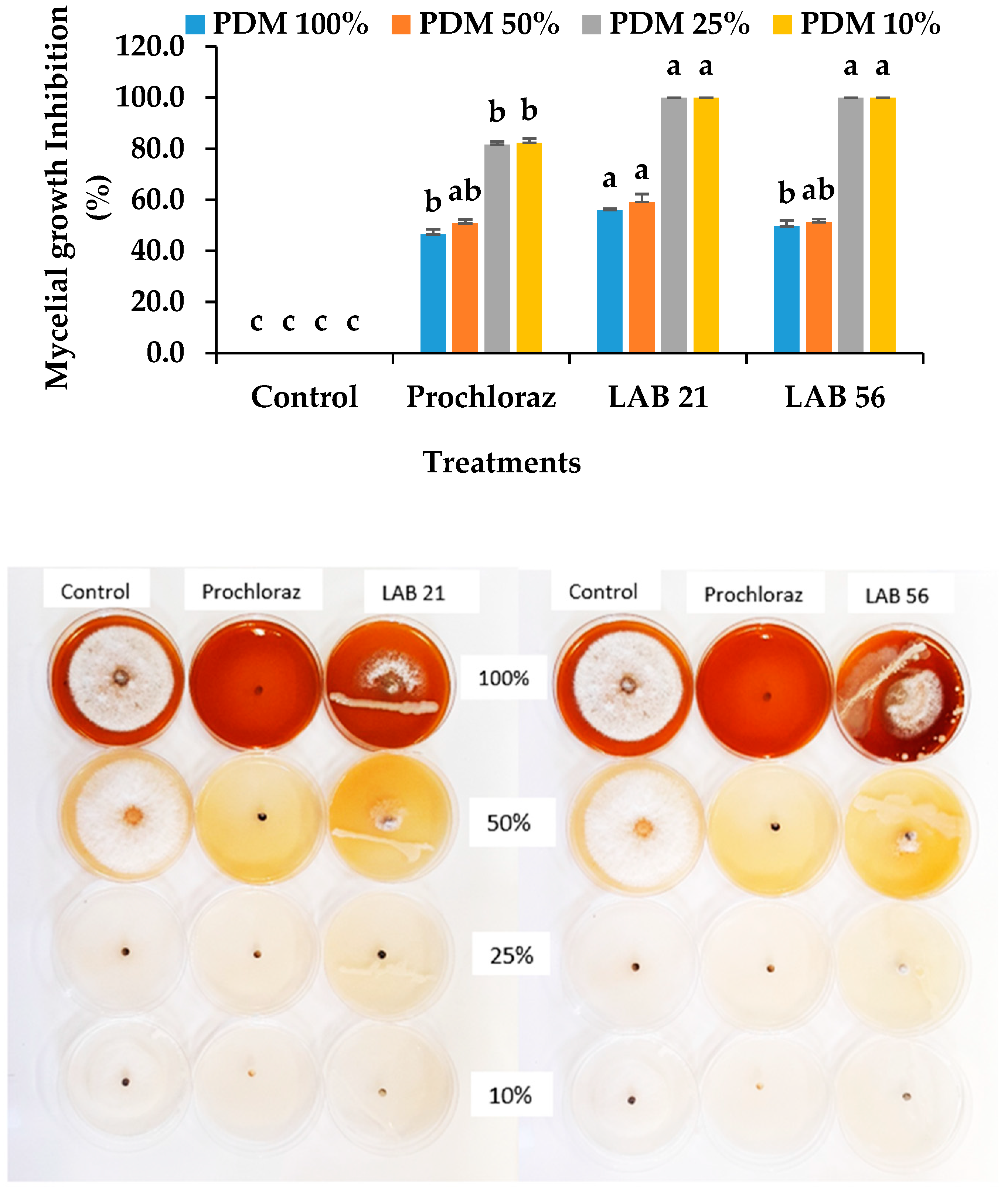

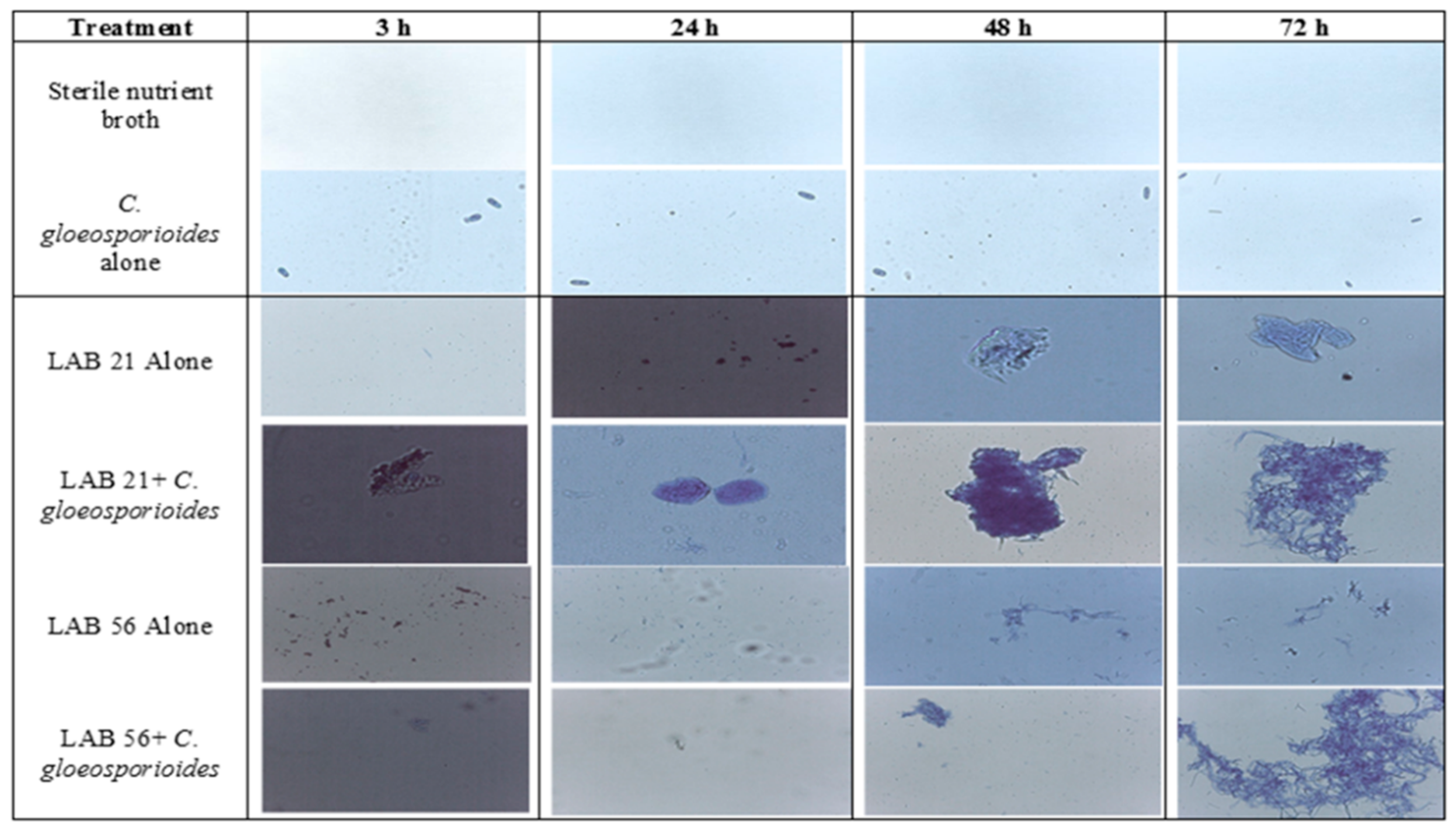
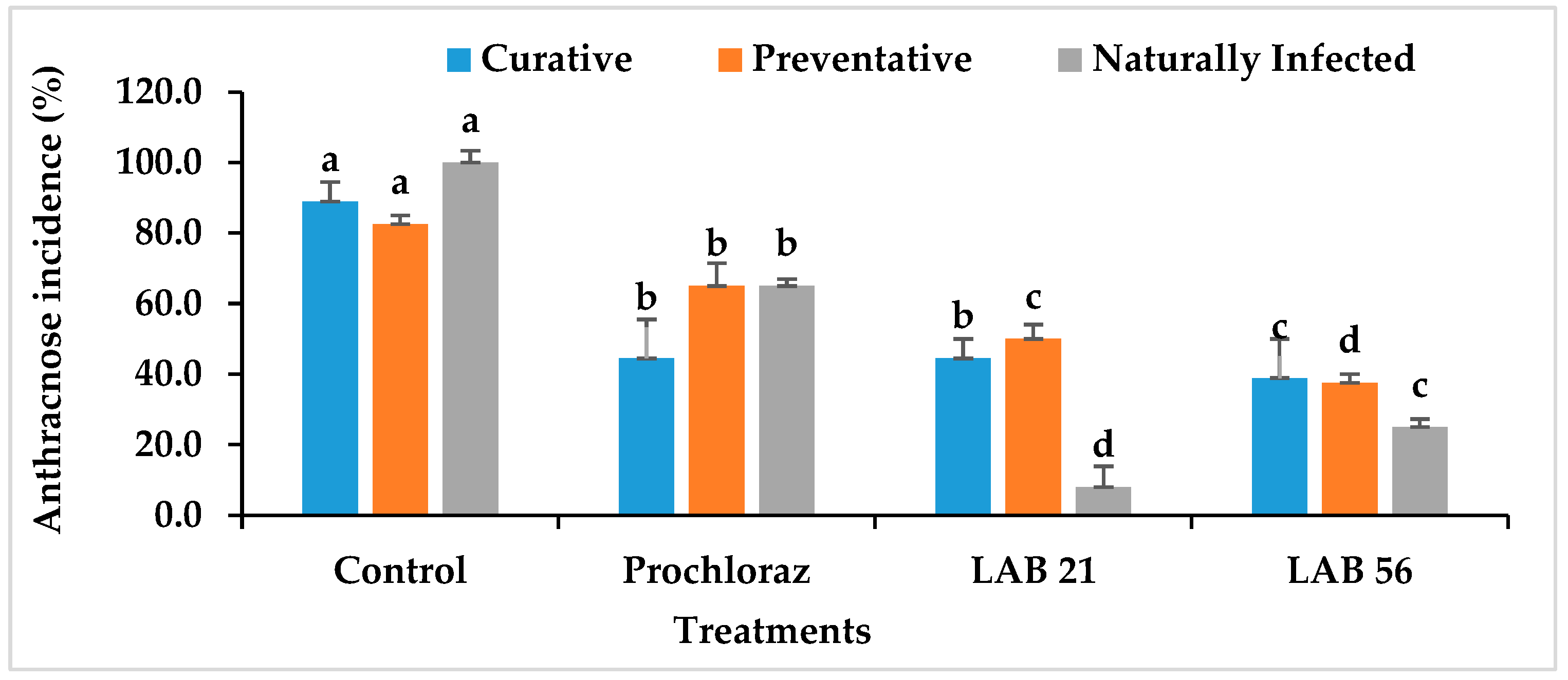
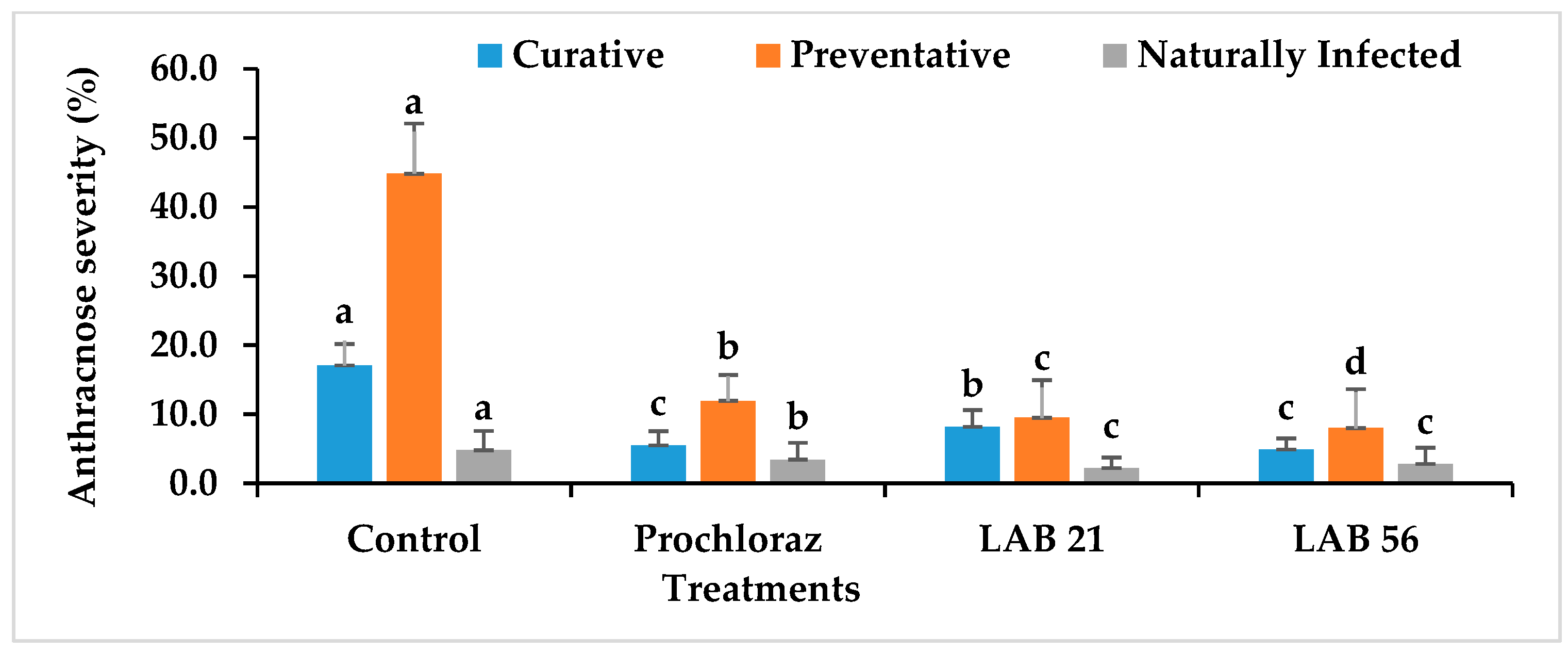
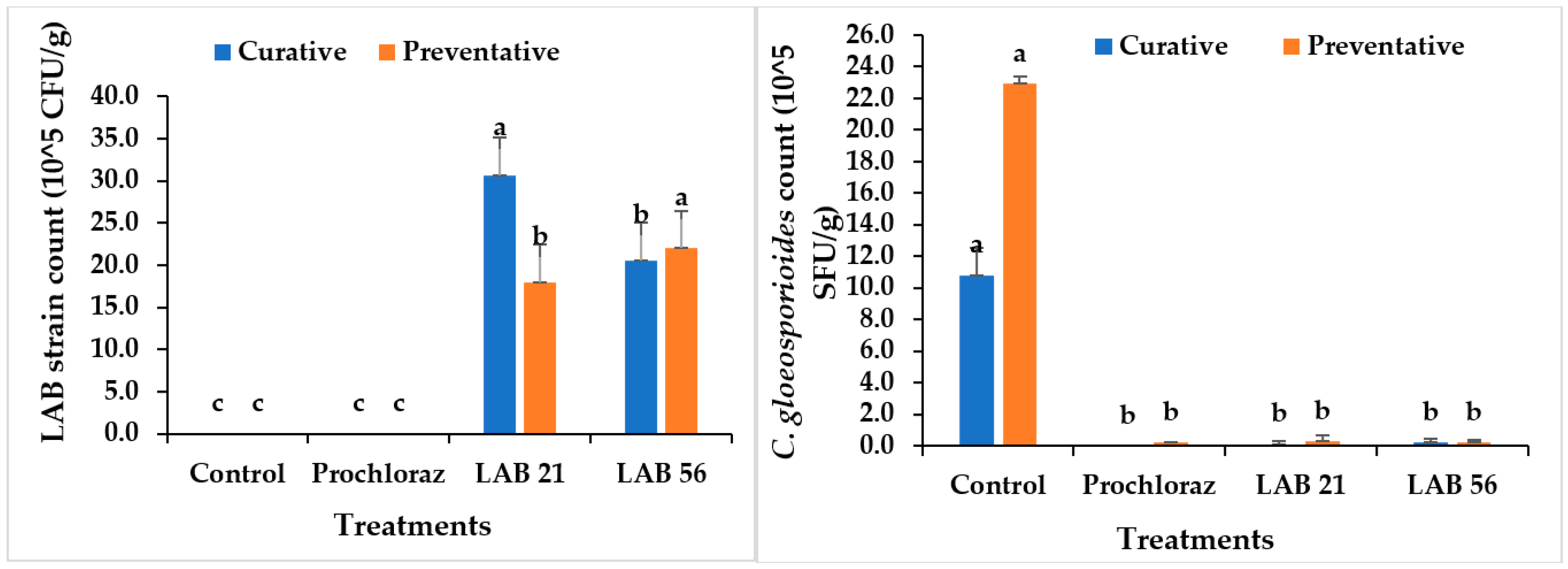

| Treatment | PAL (2−ΔΔCt) | LOX (Log 2−ΔΔCt) | AVFADL 2–3 (Log 2−ΔΔCt) | AVFAEL (Log 2−ΔΔCt) | FLS (Log 2−ΔΔCt) |
|---|---|---|---|---|---|
| Control | 210.88 ± 16.78 c | 1.05 ± 0.11 a | 1.00 ± 0.12 d | 1.01 ± 0.15 d | 1.44 ± 0.15 d |
| Prochloraz® | 614.18 ± 85.67 b | 0.65 ± 0.04 c | 2.53 ± 0.14 c | 1.84 ± 0.29 c | 2.66 ± 0.33 c |
| LAB 21 | 929.18 ± 69.55 a | 0.48 ± 0.02 d | 3.86 ± 0.34 a | 3.77 ± 0.20 a | 10.49 ± 0.20 a |
| LAB 56 | 584.06 ± 175.81 c | 0.87 ± 0.07 b | 3.75 ± 0.25 b | 2.37 ± 0.14 b | 6.68 ± 0.56 b |
| LSD | 190.83 *** | 0.29 *** | 0.84 *** | 0.75 *** | 1.28 *** |
Disclaimer/Publisher’s Note: The statements, opinions and data contained in all publications are solely those of the individual author(s) and contributor(s) and not of MDPI and/or the editor(s). MDPI and/or the editor(s) disclaim responsibility for any injury to people or property resulting from any ideas, methods, instructions or products referred to in the content. |
© 2023 by the authors. Licensee MDPI, Basel, Switzerland. This article is an open access article distributed under the terms and conditions of the Creative Commons Attribution (CC BY) license (https://creativecommons.org/licenses/by/4.0/).
Share and Cite
Mpeluza, A.S.; Akinola, S.A.; Shoko, T.; Remize, F.; Sivakumar, D. Efficacy of Lactic Acid Bacteria as a Biocontrol Agent against Anthracnose (Persea americana Miller) Decay in Avocado (Persea americana) cv Fuerte Fruit. Agriculture 2023, 13, 269. https://doi.org/10.3390/agriculture13020269
Mpeluza AS, Akinola SA, Shoko T, Remize F, Sivakumar D. Efficacy of Lactic Acid Bacteria as a Biocontrol Agent against Anthracnose (Persea americana Miller) Decay in Avocado (Persea americana) cv Fuerte Fruit. Agriculture. 2023; 13(2):269. https://doi.org/10.3390/agriculture13020269
Chicago/Turabian StyleMpeluza, Azola Siwaphiwe, Stephen Abiola Akinola, Tinotenda Shoko, Fabienne Remize, and Dharini Sivakumar. 2023. "Efficacy of Lactic Acid Bacteria as a Biocontrol Agent against Anthracnose (Persea americana Miller) Decay in Avocado (Persea americana) cv Fuerte Fruit" Agriculture 13, no. 2: 269. https://doi.org/10.3390/agriculture13020269
APA StyleMpeluza, A. S., Akinola, S. A., Shoko, T., Remize, F., & Sivakumar, D. (2023). Efficacy of Lactic Acid Bacteria as a Biocontrol Agent against Anthracnose (Persea americana Miller) Decay in Avocado (Persea americana) cv Fuerte Fruit. Agriculture, 13(2), 269. https://doi.org/10.3390/agriculture13020269








